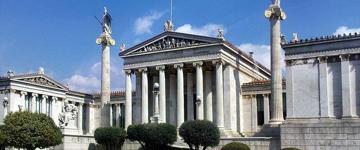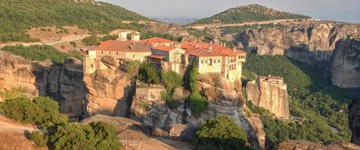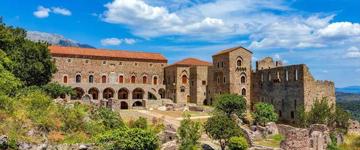Meteora Monasteries
The word Meteora means literally 'hovering in the air' and of course brings to mind the word meteor. What created this rare geological phenomenon is one of the mysteries of nature and there are many theories though they remain theories and none have been proven. But as amazing a marvel of nature as these giant rocks are the buildings on the top of these are a marvel of man and seem just as miraculous and make Meteora one of the most spectacular places to visit in Greece.
The area of Meteora was originally settled by monks who lived in caves within the rocks during the 11th Century. But as the times became more unsure during an age of Turkish occupation, brigandry and lawlessness, they climbed higher and higher up the rock face until they were living on the inaccessable peaks where they were able to build by bringing material and people up with ladders and baskets and build the first monasteries. This was also how the monasteries were reached until the nineteen twenties and now there are roads, pathways and steps to the top. There are still examples of these baskets which are used for bringing up provisions. Back in the days when these baskets were the only way to get to the monasteries a nervous pilgrim asked his monk host if they ever replace the rope. "Of course we do" he replied."Whenever it breaks", which I am sure put the guy at ease. But now you don't have to worry about ropes breaking since the monasteries are all connected by a series of pathworks that if you begin early enough you can see them all in one day. They are also connected by roads so if you are coming by car and don't have all day to wander around you can also get close enough and then continue on foot.
During the Turkish occupation it was the monasteries which kept alive the Hellenic culture and traditions and were not only relgious centers but academic and artistic as well. It is believed that were it not for the monasteries, Hellenic culture would have disappeared and modern Greece would be a reflection of the Ottoman empire with little knowledge of its roots and history. The monasteries attracted not only the deeply religious, but the philosophers, poets, painters and the deep thinkers of Greece. Today only six of the monasteries are active:
* Agia Triada or Holy Trinity
* Monastery of Agios Nikolaos Anapafsas
* Megalo Meteoro or Metamorphisis
* Varlaam Monastery
* Roussanou Monastery
* Agios Stefanos
There is a 2 euro fee to enter each of the monasteries and proper attire is required. Women must wear skirts below the knees though in some monasteries these are provided for women in shorts or slacks. Men's arms must be covered and they must wear long pants. Monasteries are closed between one and three every day. The monasteries themselves, besides prividing an incredible view are full of religious treasures, wall paintings, icons and libraries rich in old manuscripts. Most of them were built in the 1500's and then added to over the centuries.
Meteora is also a great place to go rock climbing and there is a rock climbing school for beginners as well as programs in the area for beginners and advanced climbers.
The two closest towns to Meteora are Kalambaka and Kastraki and these are where most people stay.
The name Kalambaka comes from the Turkish word Kalembak which means beautiful fortress. The Cathedral of the Dormition of the Virgin, a three-aisled basilica built in the time of Justinian and rebuilt in 1309 by Andronicus Paleologus is worth the visit. The town itself was destroyed by the Germans in World War Two so it is pretty modern with apartment buildings and a downtown that looks like a small city. Nearby is the Theopetra, a cave inhabited from Palaeolithic times.
The village of Kastraki in the shade of the rocks of Meteora is a popular destination for the rock climbers who can walk out the door of their hotel and be climbing in a few minutes. It's a great place to take walks to and from. Because of the popularity of Meteora this little town can get pretty busy in the summer.


